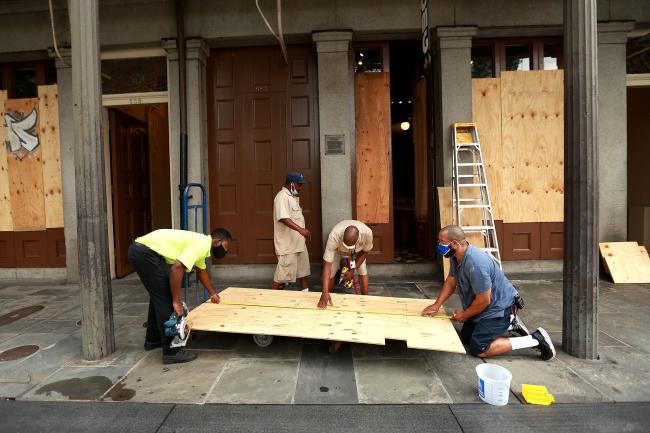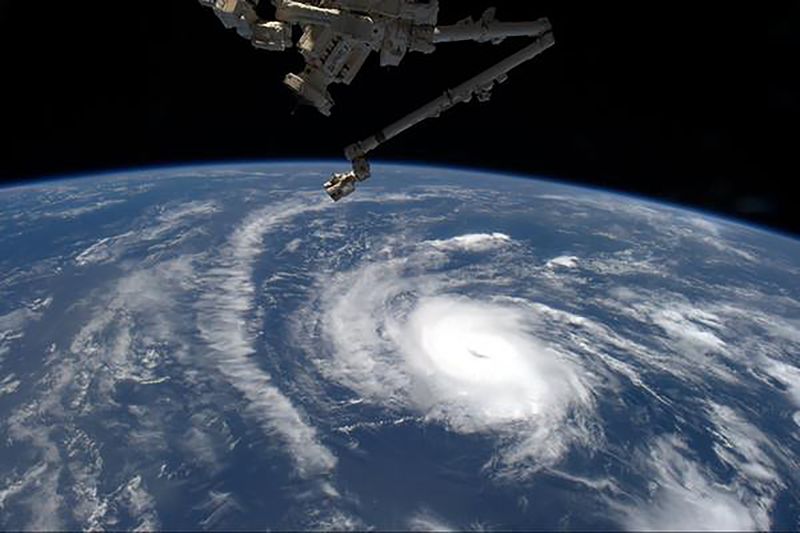(Bloomberg) -- Hurricane Laura is poised to become a roof-ripping Category 3 storm when it comes ashore along the Texas-Louisiana coast, threatening to inflict as much as $12 billion of damage on the region and potentially shutting 12% of U.S. refining capacity for months.
Laura’s winds will likely peak at 115 miles (185 kilometers) per hour as it comes ashore late Wednesday or early Thursday, the National Hurricane Center said. The storm has already disrupted offshore oil and natural gas production, shuttered refineries and export terminals and prompted mandatory evacuations. It would be the first major system to hit the Gulf Coast since Michael in 2018.
On its current track, Laura will likely cause about $5 billion in losses, but if the intensity or track shifts for the worse, the total could run as high as $12 billion, according to Chuck Watson, a disaster modeler with Enki Research. About 10% to 12% of U.S. refining capacity could be shut for more than six months, he said.
“Laura will continue to rapidly intensify over the next 24 hours before making landfall,” said Elizabeth Palumbi, a meteorologist with commercial forecaster Maxar. “Models have been inching westward on where exactly Laura will approach, so any location from Corpus Christi to west-central Louisiana is currently at risk.”
The tropical threat has prompted 82% of oil output and 57% of natural gas production in the Gulf of Mexico to be shut, according to the Interior Department’s Bureau of Safety and Environmental Enforcement.
Gulf Coast refineries and petrochemical plants are often located in low-lying areas vulnerable to flooding. In 2017, an Arkema SA (OTC:ARKAY) chemical plant about 25 miles east of Houston had a fire and explosion after it was flooded by Hurricane Harvey. Last September, Exxon shut its Beaumont refinery in Texas because of flooding from Tropical Storm Imelda.
There is a chance wind shear could cut into Laura’s top winds just before landfall, but that probably won’t change the devastating impacts the storm will bring, said Rob Miller, a meteorologist with AccuWeather Inc. Laura could push sea levels 6 to 10 feet (2 to 3 meters) higher where it comes ashore, and if conditions are right, storm surge could be as high as 15 feet, Miller said.
Laura almost certainly won’t be as damaging as Harvey, the last major hurricane to hit Texas. Harvey came ashore as a Category 4 storm and then got pinned in place by larger weather patterns, causing it to send record rains across the eastern half of the state for days. Laura may pack a severe punch at landfall, but it will quickly exit the area, reducing the potential for lingering effects. The last hurricane to hit Texas was Hanna in July.
Energy platforms in the Gulf of Mexico that account for as much as 17% of America’s oil production and about 3% of gas output are designed to withstand storms of this magnitude; they regularly shut and restart as systems pass through.
Motiva Enterprises LLC , Valero Energy Corp (NYSE:VLO). and Total SE are shutting their Port Arthur, Texas, refineries ahead of Laura. Exxon Mobil Corp (NYSE:XOM).’s Baytown refinery in southeast Texas and Phillips 66’s Lake Charles refinery in Louisiana are also shutting, according to people familiar with the matter.
The city of Port Arthur will order some residents to flee the storm starting Tuesday, according to the city’s website. Jefferson County put in place a mandatory evacuation order for all except essential personnel such as employees of oil terminals, pipelines, oil-supply facilities, hospitals and utilities, it said in a statement.
There might be some hesitation to flee Laura because of Covid-19, “but if you live in a low-lying area near the coast, this storm is a bigger threat than the virus,” Watson said.
Source: National Oceanic and Atmospheric Administration. Cost values are based on the 2020 Consumer Price Index adjusted cost
Laura is poised to menace the epicenter of the U.S. liquefied natural gas export industry, where terminals are located. Cheniere Energy (NYSE:LNG) Inc. said it was temporarily suspending operations at its Sabine Pass terminal in Louisiana, the nation’s largest.
“Although these terminals are built to withstand hurricane force winds, the storms will prevent any new vessels from approaching,” Daniel Myers, an analyst at Gelber & Associates, said in report Monday.
Western sugarcane in Louisiana between Lake Charles and Lafayette will be the most at risk from Laura, said Drew Lerner, president of World Weather Inc. in Overland Park, Kansas. Things would be worse if the storm veers more to the east.
For cotton crops, some parts of western Mississippi Delta area, central and interior parts of Arkansas also could be impacted, he said.
Texas Governor Greg Abbott, Louisiana Governor John Bel Edwards, and Mississippi Governor Tate Reeves have all declared emergencies. Laura has already killed at least nine people in Haiti and the Dominican Republic, the Associated Press reported.
Thirteen storms have now formed across the Atlantic this year, including five that hit the U.S. Tropical Storm Marco came ashore in Louisiana late Monday only to quickly fall apart.
©2020 Bloomberg L.P.

